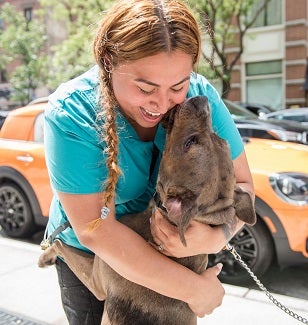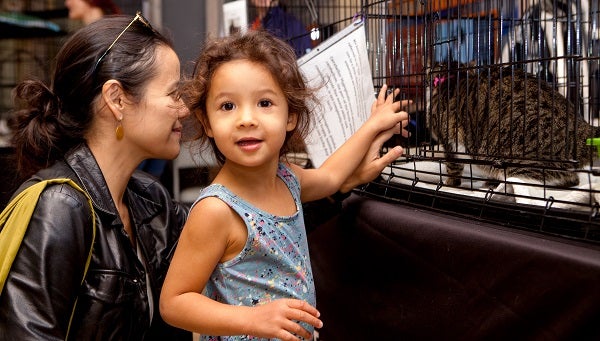
2020-2022 data trends Q&A
7/12/2023
Roundtable participants respond to additional questions about recent webinar
Last month Best Friends presented a roundtable on 2020-2022 Data Trends: A National Perspective and while the topic of data is perpetually timely, it is even more so on the heels of the recent release of our 2022 national dataset. The event focused on how seeing nationwide trends can help organizations see how they compare to similar shelters and provide a blueprint for planning new lifesaving strategies. The audience had lots of questions — so many that we ran out of time during the webinar to answer them all. We asked panelists Steve Zeidman, senior vice president of software solutions at Pethealth, Inc., and Brent Toellner, senior director of lifesaving programs at Best Friends, to weigh in on the ones we didn’t get to:
How many “strays” are really owner surrenders whose people just don’t want to make an appointment, pay a relinquishment fee, etc.? Don’t you think these people have already been turned down by organizations that only accept unowned animals and so have learned to label them as strays?
Steve Zeidman: There are always going to be strays who are not actually strays. The real question is, do we think that percent would change enough over time to affect trend lines? Personally, I don’t believe there is enough of a shift nationally to impact our data. I think this data reflects more of a return to normal than it does a new problem facing our movement.
 Brent Toellner: Since the data includes both open-admission and managed-intake brick-and-mortar shelters, it is unlikely the uptick is due to other organizations refusing to accept animals. We also know from a 2016 study of stray dogs in Dallas that was performed by Boston Consulting Group that most free-roaming dogs are really “stray/owned” animals that are not properly contained by their owners.
Brent Toellner: Since the data includes both open-admission and managed-intake brick-and-mortar shelters, it is unlikely the uptick is due to other organizations refusing to accept animals. We also know from a 2016 study of stray dogs in Dallas that was performed by Boston Consulting Group that most free-roaming dogs are really “stray/owned” animals that are not properly contained by their owners.
I think we’re seeing increased stray intakes because animal services teams are more fully staffed and thus able to corral more at-large dogs. Instead, those officers could be spending their time on proactive programs like return-to-owner (RTO) in the field, which relies on actions like scanning for microchips and door knocking. (For guidance on how to implement such programs, officers should review our webinar, “Beyond the Scanner: Advanced Field RTO in the Field Techniques.”) Similarly, we can minimize stray intake from Good Samaritans with “friendly finder” programs asking people to temporarily foster the dog while they search for the owner (who more than likely lives near where the dog was found).
What are your thoughts about municipal shelters declining strays to maintain their no-kill status?
Brent: Even the nicest shelter is a tough environment for most pets, which is why these agencies should be seen as a last resort. However, it is concerning and causes public frustration when shelters won’t accept an animal yet don’t provide resources and guidance about alternatives.
Every shelter should establish an appointment-based intake system and use the intervening period to have a conversation about whether the shelter is really the best option for that individual pet, as well as offer resources to avoid such a choice. For example, people are often able to keep their pets if they have basic supplies such as food or toys or can be educated about simple behavior tips. When keeping a pet isn’t an option, owners can be empowered to find a good home for their dog or cat with a little guidance along with the use of apps like Rehome by Adopt-A-Pet.com. The increased use of these efforts, as well as foster/finder programs, has led to a decline in shelter intake over time.
What’s the difference between length of stay (LOS) and days in care?
Brent: Days in care provides a measurement of how long an animal is in the shelter and applies to current residents, whereas LOS (or more accurately, average LOS) is a calculation that occurs once an animal has left the shelter, and measures how long it took before that dog or cat had a live or non-live outcome. Both are important measures of a shelter’s capacity for care. (The updated “Guidelines for Standards of Care in Animal Shelters” from the Association of Shelter Veterinarians includes a chart showing the impact of longer LOS on shelter capacity.)
How do you account for such a drastic increase in LOS and overall shelter populations when intake hasn't drastically increased, and outcomes look relatively stable?
Brent: Simply put, outcomes are lagging intakes. That may be due to sluggish adoptions, stagnation in transfers, or lack of access to veterinary services, but shelters should be taking as many steps as possible to increase the pace of live outcomes by solving those issues. Some options to do this are reducing barriers to adoption, implementing better disease management protocols, and finding innovative solutions like foster-to-adopt adoptions for unaltered animals.
Does data exist explaining why there are fewer adoptions? Are more people choosing to buy pets instead of adopting them?
Steve: Shelter software systems don’t track this kind of data, but it is likely due to a combination of many factors, many of which have nothing to do with the pets themselves.
 Brent: The best resource for pet acquisition data is from the American Pet Products Association (APPA); you can also review the results of our 2022 study Consumer Adoption Research Analysis. Both data sources show some migration of preference, such as a slight decrease in acquisition from shelters and rescues and a slight increase from friends, family, and/or independent breeders. The fact that people are getting pets from private individuals is not surprising, especially considering the increase in attention given to home-to-home rehoming apps.
Brent: The best resource for pet acquisition data is from the American Pet Products Association (APPA); you can also review the results of our 2022 study Consumer Adoption Research Analysis. Both data sources show some migration of preference, such as a slight decrease in acquisition from shelters and rescues and a slight increase from friends, family, and/or independent breeders. The fact that people are getting pets from private individuals is not surprising, especially considering the increase in attention given to home-to-home rehoming apps.
The fact that more pets are coming from breeders is concerning, especially because it’s more pronounced among younger millennials and Gen Z. Marketing to offset this trend should be happening locally, but it means shelters must tell their community about the need for adoptions and invite them to help.
Shelters should look at internal barriers to adoption that might be making purchasing a more attractive option. Are adoption hours convenient for the public? Is the public being warmly greeted and getting good customer service while they are there? Are adoption barriers turning people away? Is that especially the case with renters or people from various racial or ethnic backgrounds, both of which are more likely to be from younger demographics? These are good places to start in overcoming the slight shift in trends.
How can we increase the number of hours our shelter is open when we don’t have the staffing?
Brent: Consider adjusting your hours. Instead of being open from noon to 4 p.m. Monday through Friday, can you shift those hours from 2 to 6 p.m. so people can come by after work? Instead of relying entirely on staff, tap into your volunteers. Ask if they will come in from 5 to 7 p.m. one night a week to support adoptions. Start the next conversation with your team not with “we don’t have enough staffing to do this,” but “what would it take to make this happen?” Try their suggestions. If something doesn’t work, you can always shift back to your regular hours. We can’t keep doing things exactly the same and expect different results.
I was surprised to see the number of dog adoptions stay the same from 2020 to 2023. It seems incongruent with the stories coming out during the pandemic that shelters were clearing out space, even provoking discussion about what would happen if the demand for dogs exceeded supply. Am I interpreting the data correctly that the supply has increased (due to stray) while demand has stayed the same?
Steve: Prior to 2020, the supply of dogs from shelters was slowly shrinking. In 2020, it plummeted. It didn’t drop because of demand, however; it dropped because the supply halted. We know for sure that the “big adoption wave” in 2020 was a myth and the “big surrender wave” of 2021 was a myth.
As for demand, I wouldn’t use adoption numbers as a measure. Demand almost always finds a supply. The big question is, are shelters being hurt by that “other” supply? My gut feeling is that we are, with online breeders filling the gap that started before 2020 and which has continued even with an increased supply in shelters.

Mega adoption events seemed to have lost their appeal. In 2018, a mega adoption event in our area resulted in more than 260 adoptions, but this year it resulted in around 50. If free adoptions aren’t moving dogs, what else can we try?
Brent: A lot has changed since the pandemic and there likely are some lessons to learn by closely scrutinizing your events after the fact. You may have to try new things to get the same results you used to. Do an evaluation of your shelter’s:
- Marketing: Is the messaging similar? Does it convey the same sense of urgency or happiness? Are you sharing positive adoption results after events to create buzz leading into the next event?
- Social media posts: Are they getting the same level of engagement? Shares? Comments? Facebook has changed their algorithm and posts are getting a small fraction of the views they used to. What can we adjust? Can we pay to boost posts?
- Media hits: Are you getting the same media exposure? Do you need to build relationships with new reporters who have started in your market over the past few years?
- Customer service: When people get to the shelter, are they getting the same warm greetings and hospitality they had gotten previously? Are there any new adoption barriers in place?
Most of the directors I know who feel overwhelmed have been doing this for 20 years, but this year is different. We are doing all the things we were doing in 2018 and 2019 when we were taking in more dogs and our policies are far less restrictive, yet adoptions are down 30% year-over-year. There MUST be a bigger social trend happening; it feels like we're focused on 2019 answers to totally different 2023 problems.
Brent: First of all, congrats on increasing the accessibility of your adoptions in your community. This is a great step. Best Friends is consistently looking at all sources for larger societal trends and we promise to send updates if we uncover anything. It’s important to remember this work has always been hard. More animals coming in than going out, high staff turnover, economic pressures, etc., have always been a challenge. Hang in there. Keep innovating. And most importantly, take care of yourself. Through collaboration we can continue to find solutions that work in 2023 and be generous about sharing them.
Click here to see the PowerPoint from the webinar.

Liz Finch
Senior Writer
Best Friends Network
If you enjoyed this program spotlight, you can find our complete catalog of spotlights here.